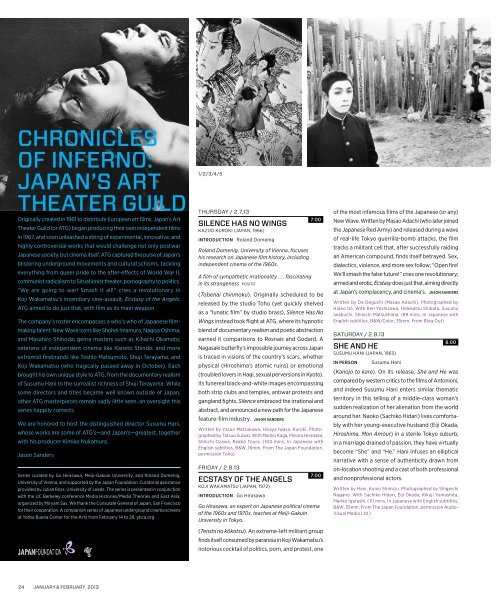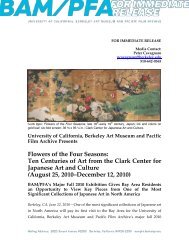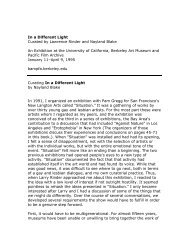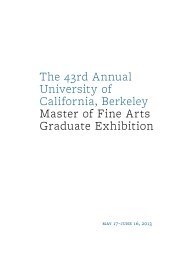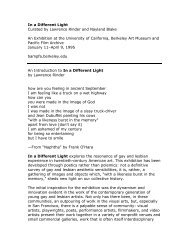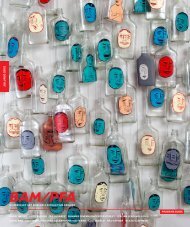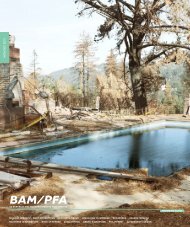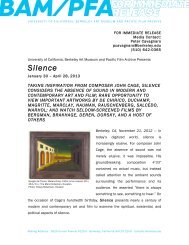January & February 2013 - Berkeley Art Museum and Pacific Film ...
January & February 2013 - Berkeley Art Museum and Pacific Film ...
January & February 2013 - Berkeley Art Museum and Pacific Film ...
- No tags were found...
You also want an ePaper? Increase the reach of your titles
YUMPU automatically turns print PDFs into web optimized ePapers that Google loves.
FILMSChroniclesof Inferno:japan’s <strong>Art</strong>Theater GuildOriginally created in 1961 to distribute European art films, Japan’s <strong>Art</strong>Theater Guild (or ATG) began producing their own independent filmsin 1967, <strong>and</strong> soon unleashed a string of experimental, innovative, <strong>and</strong>highly controversial works that would challenge not only postwarJapanese society, but cinema itself. ATG captured the pulse of Japan’sblistering underground movements <strong>and</strong> cultural schisms, tacklingeverything from queer pride to the after-effects of World War II,communist radicalism to Situationist theater, pornography to politics.“We are going to war! Smash it all!” cries a revolutionary inKoji Wakamatsu’s incendiary cine-assault, Ecstasy of the Angels;ATG aimed to do just that, with film as its main weapon.The company’s roster encompasses a who’s who of Japanese filmmakingtalent: New Wave icons like Shohei Imamura, Nagisa Oshima,<strong>and</strong> Masahiro Shinoda; genre masters such as Kihachi Okamoto;veterans of independent cinema like Kaneto Shindo; <strong>and</strong> moreextremist firebr<strong>and</strong>s like Toshio Matsumoto, Shuji Terayama, <strong>and</strong>Koji Wakamatsu (who tragically passed away in October). Eachbrought his own unique style to ATG, from the documentary realismof Susumu Hani to the surrealist richness of Shuji Terayama. Whilesome directors <strong>and</strong> titles became well known outside of Japan,other ATG masterpieces remain sadly little seen, an oversight thisseries happily corrects.We are honored to host the distinguished director Susumu Hani,whose works are some of ATG’s—<strong>and</strong> Japan’s—greatest, togetherwith his producer Kimiko Nukamura.Jason S<strong>and</strong>ersSeries curated by Go Hirasawa, Meiji-Gakuin University, <strong>and</strong> Rol<strong>and</strong> Domenig,University of Vienna, <strong>and</strong> supported by the Japan Foundation. Curatorial assistanceprovided by Julian Ross, University of Leeds. The series is presented in conjunctionwith the UC <strong>Berkeley</strong> conference Media Histories/Media Theories <strong>and</strong> East Asia,organized by Miryam Sas. We thank the Consulate General of Japan, San Franciscofor their cooperation. A companion series of Japanese underground cinema screensat Yerba Buena Center for the <strong>Art</strong>s from <strong>February</strong> 14 to 28, ybca.org.1/2/3/4/5Thursday / 2.7.13Silence Has No WingsKazuo Kuroki (Japan, 1966)Introduction Rol<strong>and</strong> DomenigRol<strong>and</strong> Domenig, University of Vienna, focuseshis research on Japanese film history, includingindependent cinema of the 1960s.7:00A film of sympathetic irrationality . . . fascinatingin its strangeness Positif(Tobenai chinmoku). Originally scheduled to bereleased by the studio Toho (yet quickly shelvedas a “lunatic film” by studio brass), Silence Has NoWings instead took flight at ATG, where its hypnoticblend of documentary realism <strong>and</strong> poetic abstractionearned it comparisons to Resnais <strong>and</strong> Godard. ANagasaki butterfly’s impossible journey across Japanis traced in visions of the country’s scars, whetherphysical (Hiroshima’s atomic ruins) or emotional(troubled lovers in Hagi, sexual perversions in Kyoto).Its funereal black-<strong>and</strong>-white images encompassingboth strip clubs <strong>and</strong> temples, antiwar protests <strong>and</strong>gangl<strong>and</strong> fights, Silence embraced the irrational <strong>and</strong>abstract, <strong>and</strong> announced a new path for the Japanesefeature-film industry. Jason S<strong>and</strong>ersWritten by Yasuo Matsukawa, Hisaya Iwasa, Kuroki. Photographedby Tatsuo Suzuki. With Mariko Kaga, Minoru Hiranaka,Shôichi Ozawa, Rokkô Toura. (100 mins, In Japanese withEnglish subtitles, B&W, 16mm, From The Japan Foundation,permission Toho)Friday / 2.8.13Ecstasy of the AngelsKoji Wakamatsu (Japan, 1972)Introduction Go Hirasawa7:00Go Hirasawa, an expert on Japanese political cinemaof the 1960s <strong>and</strong> 1970s, teaches at Meiji-GakuinUniversity in Tokyo.(Tenshi no kōkotsu). An extreme-left militant groupfinds itself consumed by paranoia in Koji Wakamatsu’snotorious cocktail of politics, porn, <strong>and</strong> protest, oneof the most infamous films of the Japanese (or any)New Wave. Written by Masao Adachi (who later joinedthe Japanese Red Army) <strong>and</strong> released during a waveof real-life Tokyo guerrilla-bomb attacks, the filmtracks a militant cell that, after successfully raidingan American compound, finds itself betrayed. Sex,dialectics, violence, <strong>and</strong> more sex follow; “Open fire!We’ll smash the false future!” cries one revolutionary;armed <strong>and</strong> erotic, Ecstasy does just that, aiming directlyat Japan’s complacency, <strong>and</strong> cinema’s. Jason S<strong>and</strong>ersWritten by De Deguchi (Masao Adachi). Photographed byHideo Itô. With Ken Yoshizawa, Hidekatsu Shibata, SusumuIwabuchi, Shinichi Matsushima. (89 mins, In Japanese withEnglish subtitles, B&W/Color, 35mm, From Blaq Out)Saturday / 2.9.13She <strong>and</strong> HeSusumu Hani (Japan, 1963)8.00In Person Susumu Hani(Kanojo to kare). On its release, She <strong>and</strong> He wascompared by western critics to the films of Antonioni,<strong>and</strong> indeed Susumu Hani enters similar thematicterritory in this telling of a middle-class woman’ssudden realization of her alienation from the worldaround her. Naoko (Sachiko Hidari) lives comfortablywith her young-executive husb<strong>and</strong> (Eiji Okada,Hiroshima, Mon Amour) in a sterile Tokyo suburb;in a marriage drained of passion, they have virtuallybecome “She” <strong>and</strong> “He.” Hani infuses an ellipticalnarrative with a sense of authenticity drawn fromon-location shooting <strong>and</strong> a cast of both professional<strong>and</strong> nonprofessional actors.Written by Hani, Kunio Shimizu. Photographed by ShigeichiNagano. With Sachiko Hidari, Eiji Okada, Kikuji Yamashita,Mariko Igarashi. (111 mins, In Japanese with English subtitles,B&W, 35mm, From The Japan Foundation, permission Audio-Visual Media Ltd.)24 january & FEBRuary <strong>2013</strong>


